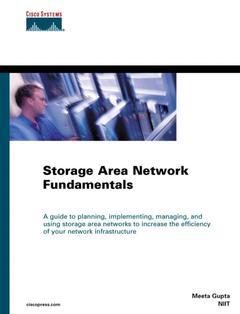Description
Storage Area Network Fundamentals
Author: GUPTA Meeta
Language: English
Subject for Storage Area Network Fundamentals:
Approximative price 59.52 €
Subject to availability at the publisher.
Add to cart302 p. · 19x23 cm · Hardback
Description
/li>Contents
/li>
Plan, implement, manage, and use SANs to increase the efficiency of your network infrastructure.
- An in-depth coverage of SAN fundamentals, topologies, implementation and management techniques, and products.
- Scenario based questions and hands-on exercises facilitate real-life problem solving
- Post-chapter assessment questions to test the readers understanding.
Raman Nagpal, is an Engineer in Computer Science from Delhi Institute of Technology(DIT), Delhi, India. He holds a Post Graduate Diploma in International Business from AIMA, Delhi. He also holds a certificate in PSP (Personal Software Process) from SEI, Carnegie Mellon University. Raman has over 6 years of industry experience, with the last two years working extensively on SAN technologies. Raman is currently working on Windows 2000 enablement of the Celestra technology, a pioneering SAN-enabled offering from Legato Systems India as manager. Prior to this, he worked on Middleware for Legatos storage management products.
(NOTE: Each chapter concludes with a Summary.)
Introduction.
1. Networking and Storage Concepts.
2. Introduction to Storage Area Networks.
3. Fibre Channel Basics.
4. Fibre Channel Products.
5. Fibre Channel Cabling.
6. SAN Topologies.
7. Designing and Building a SAN.
8. Implementing SAN Security.
9. Problem Isolation and Management of SANs.
10. iSCSI Technology.
11. Future of SANs.
Appendix A. RAID Technology and Fibre Channel Vendors.
Glossary.




